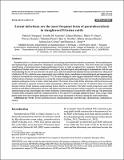Por favor, use este identificador para citar o enlazar a este item:
http://hdl.handle.net/10261/113407COMPARTIR / EXPORTAR:
 SHARE SHARE
 CORE
BASE CORE
BASE
|
|
| Visualizar otros formatos: MARC | Dublin Core | RDF | ORE | MODS | METS | DIDL | DATACITE | |

| Título: | Latent infections are the most frequent form of paratuberculosis in slaughtered Freisian cattle |
Autor: | Vázquez, Patricia; Garrido, J. M.; Molina, Elena CSIC ORCID ; Geijo, M. V.; Gómez, Nieves; Pérez Pérez, Valentín CSIC ORCID ; Sevilla, Iker A.; Alonso Hearn, M.; Cortés, Adoración; Juste, Ramón A. | Palabras clave: | Bovine paratuberculosis Immunopathology Microbiology Epidemiology Pathogenesis Latency |
Fecha de publicación: | 2014 | Editor: | CSIC - Instituto Nacional de Investigación y Tecnología Agraria y Alimentaria (INIA) | Citación: | Spanish Journal of Agricultural Research 12: 1049- 1060 (2014) | Resumen: | Paratuberculosis is a chronic mycobacterial infection causing granulomatous enteritis in ruminants, whose pathogenesis and epidemiology poses numerous challenges, including latency and reactivation. The most recent and complete classification of paratuberculosis immunopathological types in cattle recognized five categories. In this study, 1031 slaughtered Friesian cattle were submitted to serological, microbiological and pathological examinations with the aim of maximizing the rate of case detection. In most cases, infected animals had minimal lesions and almost no other proof of infection (38.9%), while the more characteristic types with the whole constellation of microbiological and immunological evidences accounted for a lower proportion (7.7%). As these findings in cattle suggest similarities with the epidemiology of tuberculosis in humans, we propose to re-group the original immunopathological types into two broader paratuberculosis epidemio-pathogenic forms or states: latent and patent. The former term would define infections with focal lesions and might constitute an apparent resilience status representing a difficult to detect reservoir of infection whose role could become critical if later immune-compromising factors lead to re-activation. The latter would group those cases with multifocal and diffuse inflammatory lesions with higher mycobacterial load and viability suggestive of a more immediate epidemiological risk. Interestingly, the relative frequency of presentation of each profile varied with age. The proportion of latent forms remained relatively constant between 33.8% and 54.3% through adulthood from 3 years of age, while patent forms were more frequent during the first years of age and tended to decrease among the oldest individuals. | Descripción: | 12 páginas, 3 tablas, 2 figuras. | Versión del editor: | http://dx.doi.org/10.5424/sjar/2014124-5978 | URI: | http://hdl.handle.net/10261/113407 | DOI: | 10.5424/sjar/2014124-5978 | ISSN: | 1695-971X |
| Aparece en las colecciones: | (IGM) Artículos |
Ficheros en este ítem:
| Fichero | Descripción | Tamaño | Formato | |
|---|---|---|---|---|
| Pérez, V._ et al._Latent infections are the most_2014 Spanish Journal of Agricultural Research.pdf | 2,12 MB | Adobe PDF |  Visualizar/Abrir |
CORE Recommender
SCOPUSTM
Citations
13
checked on 20-abr-2024
WEB OF SCIENCETM
Citations
9
checked on 29-feb-2024
Page view(s)
306
checked on 22-abr-2024
Download(s)
308
checked on 22-abr-2024
Google ScholarTM
Check
Altmetric
Altmetric
NOTA: Los ítems de Digital.CSIC están protegidos por copyright, con todos los derechos reservados, a menos que se indique lo contrario.
